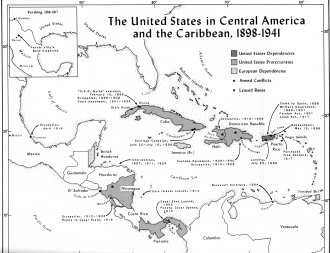

Americans arrived in Cuba on a self-proclaimed mission of redemption, self-consciously in the role of liberators, to release the downtrodden Cubans from Spanish colonial oppression. Spain had indeed been defeated and expelled, thus they inferred easily enough that the mission of liberation had been achieved. Intention of purpose shaped the perception of outcome. The United States had accomplished what it set out to do, thereby fixing the enduring representation of 1898. In the process, Cubans were transformed from active to passive, from subjects to objects, from agents of their own liberation to recipients of North American largess. (Louis Pérez Jr., "Incurring a Debt of Gratitude: 1898 and the Moral Sources of United States Hegemony in Cuba," The American Historical Review, April 1999, p. 362).After 1898 the U.S. imposed its own conditions on Spain's former colonies, especially Cuba, and intervened frequently in the internal affairs of countries in the Caribbean basin (see map above). The cartoons in this visual tour show American perceptions of the U.S. role as "protector" and "liberator" of Cubans and others, who are portrayed as inferior. The racial and gender representations in these cartoons reinforce expected and assumed roles: Cubans, Mexicans, Puerto Ricans, etc. are shown as children--i.e. as incapable of settling their own affairs--usually as non-whites and often as little girls in need of "protection" from the (always adult white male) figure (often Uncle Sam) representing the U.S. This tour takes you through ten cartoons arranged chronologically from 1898 to 1921. Pay more attention to the representation of the figures than the specific details of the cartoons, which vary in theme with the flow of time. What can these images of an emerging empire tell us about American attitudes toward Cuba and the people of the Caribbean basin at the time and since? In his intriguing account, Pérez interprets the rise of Fidel Castro and the Cuban Revolution of 1959 as a reaction, at least in part, against American paternalism in its dealings with Cuba and as an affirmation of Cuban manhood.
|
|
|
|